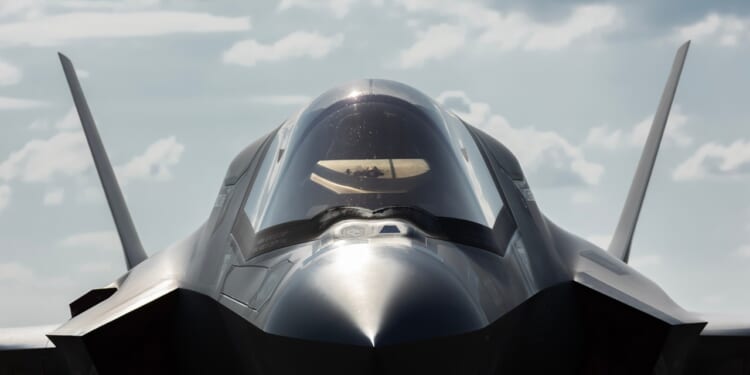The biggest unanswered question is which one of two major aerospace contractors—Boeing or Northrop Grumman—will win the F/A-XX contract.
Just weeks after President Donald Trump and Secretary of Defense Pete Hegseth announced that Boeing would produce the F-47 for the United States Air Force, there was speculation that a follow-up notice would be issued for the United States Navy’s sixth-generation F/A-XX program. Yet more than six months have passed since Boeing was named as the prime contractor for the sixth-generation manned fighter that will be the centerpiece of the Next Generation Air Dominance (NGAD) program, and there has been no word regarding the contract for the F/A-XX. That aircraft will eventually replace the aging Boeing F/A-18 Super Hornet.
Over the summer, the two likely finalists, Boeing and rival Northrop Grumman, respectively shared conceptual images that gave some hints into the designs for the F/A-XX. Lockheed Martin, which already produces variants of the F-35 for both the Navy and the Air Force, was ejected from the program earlier in the year.
This week, there is news that a contractor may finally be named from the two remaining competitors. Reuters reported that last Friday, Hegseth made “the decision to move ahead with a selection,” which could be announced in the coming days.
“Last-minute snags have delayed progress on the Navy jet in the past and could do so again,” a source within the Pentagon told Reuters.
The Navy Needs the F/A-XX Sooner Than Later
There had been speculation that some in the Department of Defense (DoD) had questioned whether Congress would provide adequate funding for both sixth-generation fighter programs. However, there have also been equal concerns that failure to move forward would leave the US Navy without an aircraft needed for carrier-based operations in the 2030s and beyond.
There had been past calls to keep the funding to a minimum, with around $74 million directed to the program while issues with supply chain capacity were addressed. That would have delayed the F/A-XX by up to three years, a time that critics of such a move said would be detrimental to the program’s success. However, the Air Force’s NGAD effort had faced similar turbulence last year, as some officials voiced concerns that technology was increasing so rapidly that a future aircraft could be obsolete only years after its arrival.
Notably, however, China and Russia have each advanced their own plans to develop a sixth-generation fighter. This unfortunate fact has forced lawmakers and the US Navy to move forward, with at least $750 million directed to the F/A-XX program via the spending bill signed into law earlier this year. An additional $1.4 billion has been earmarked for the sixth-generation carrier-based fighter in fiscal year 2026 (FY 2026), which nominally began on October 1; however, no funding has yet been allocated by Congress for the year, leading to the ongoing government shutdown.
The Navy Has More Planes Already on the Way
The United States Navy continues to acquire the F/A-18E/F Super Hornet, with the final aircraft from Block III scheduled for delivery by the end of 2027. That will mark the end of the line for the multirole carrier-based fighter, which first entered service in 1999. While still a capable fighter, there are concerns that it may be showing its age in the next decade, as China adopts multiple fifth-generation carrier-based combat aircraft.
The US Navy and United States Marine Corps currently operate the Lockheed F-35C, the carrier-based variant of the Joint Strike Fighter. The Super Hornet can carry larger weapons and serve in an electronic warfare (EW) role that the F-35C cannot. Thus, the two current aircraft complement one another, and the F-35C was never intended to replace the F/A-18E/F and its E-18 Growler variant.
In total, the Navy could operate around 420 Super Hornets and around 270 F-35Cs.
How the F/A-XX Will Improve on the F/A-18 and F-35C
As a sixth-generation fighter, the F/A-XX would be even more advanced than the F-35C, featuring improved stealth capabilities, but more importantly, greater range and endurance. The F/A-XX will be the center of a “Family of Systems” (FoS). It will likely be supported by unmanned aerial systems, including the now-in-development Collaborative Combat Aircraft (CCA), which would serve as de facto “loyal wingmen” and act as force multipliers.
The biggest unanswered question is which of the two companies—Boeing or Northrop Grumman—will win the contract. Boeing is the maker of the Super Hornet, and was awarded the NGAD contract to build the F-47. Those factors could play in its favor, as Boeing could more easily transition from the Super Hornet into the F/A-XX; however, at the same time, it may be seen as spreading itself too thin, given that it is also developing the Air Force’s fighter.
On the other side of the equation, Northrop Grumman has a long history (via its Grumman side of the business) with carrier-based aircraft from the Grumman FF-1 “Fifi” to the F-14 Tomcat. Yet Northrop Grumman is also building the B-21 Raider, as well as the LGM-35 Sentinel intercontinental ballistic missile (ICBM) for the US Air Force.
One way or another, the answer will soon be revealed.
About the Author: Peter Suciu
Peter Suciu has contributed over 3,200 published pieces to more than four dozen magazines and websites over a 30-year career in journalism. He regularly writes about military hardware, firearms history, cybersecurity, politics, and international affairs. Peter is also a contributing writer for Forbes and Clearance Jobs. He is based in Michigan. You can follow him on Twitter: @PeterSuciu. You can email the author: [email protected].
Image: Shutterstock / kamilpetran.

















